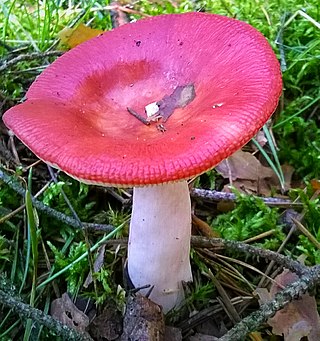
Russula emetica, commonly known as the sickener, emetic russula, or vomiting russula, is a basidiomycete mushroom, and the type species of the genus Russula. It has a red, convex to flat cap up to 8.5 cm (3.3 in) in diameter, with a cuticle that can be peeled off almost to the centre. The gills are white to pale cream, and closely spaced. A smooth white stem measures up to 10.5 cm (4.1 in) long and 2.4 cm (0.9 in) thick. First described in 1774, the mushroom has a wide distribution in the Northern Hemisphere, where it grows on the ground in damp woodlands in a mycorrhizal association with conifers, especially pine.
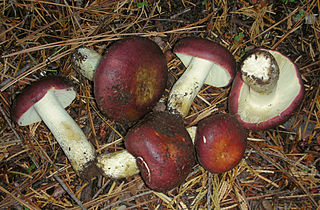
Russula xerampelina, also commonly known as the shrimp russula, crab brittlegill, or shrimp mushroom, is a basidiomycete mushroom of the brittlegill genus Russula. Two subspecies are recognised. The fruiting bodies appear in coniferous woodlands in autumn in northern Europe and North America. Their caps are coloured various shades of wine-red, purple to green. Mild tasting and edible, it is one of the most highly regarded brittlegills for the table. It is also notable for smelling of shellfish or crab when fresh.

Russula virescens is a basidiomycete mushroom of the genus Russula, and is commonly known as the green-cracking russula, the quilted green russula, or the green brittlegill. It can be recognized by its distinctive pale green cap that measures up to 15 cm (6 in) in diameter, the surface of which is covered with darker green angular patches. It has crowded white gills, and a firm, white stipe that is up to 8 cm (3 in) tall and 4 cm (1.6 in) thick. Considered to be one of the best edible mushrooms of the genus Russula, it is especially popular in Spain and China. With a taste that is described variously as mild, nutty, fruity, or sweet, it is cooked by grilling, frying, sautéeing, or eaten raw. Mushrooms are rich in carbohydrates and proteins, with a low fat content.

Sparassis crispa is a species of fungus in the family Sparassidaceae. It is sometimes called cauliflower fungus.

Russula cyanoxantha, synonymous with R. xyanoxantha, commonly known as the charcoal burner or variegated russula, is a basidiomycete mushroom, distinguished from most other members of the genus Russula by the fact that its gills do not split, but are soft and flexible. It is one of the most common species of Russula in Europe.

Russula claroflava, commonly known as the yellow russula, yellow swamp russula or yellow swamp brittlegill, is a basidiomycete mushroom of the genus Russula. It is found in wet places under birch and aspen woodlands across Europe and North America. It has a yellow cap, white gills and stipe and bruises grey. It is mild-tasting and regarded as good to eat.

Russula nigricans, commonly known as the blackening brittlegill or blackening russula, is a gilled mushroom found in woodland in Europe. It gains both its common and scientific name from its propensity to turn black from cutting or bruising.
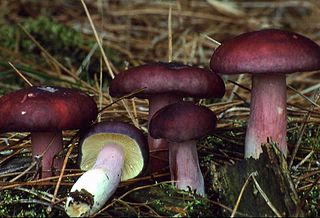
Russula sardonia, commonly known as the primrose brittlegill, is a mushroom of the genus Russula, which are commonly known as brittlegills. The fruiting body, or mushroom, is a reddish-purple, the colour of blackberry juice, and is found in coniferous woodland in summer and autumn. It is inedible, and like many inedible members of the genus, has a hot, peppery taste.

Russula sanguinaria, commonly known as the bloody brittlegill or rosey russula, is a strikingly coloured mushroom of the genus Russula, which has the common name of brittlegills. It is bright blood-red, inedible, and grows in association with coniferous trees. It was previously widely known as Russula sanguinea.

Russula brevipes is a species of mushroom commonly known as the short-stemmed russula or the stubby brittlegill. It is widespread in North America, and was reported from Pakistan in 2006. The fungus grows in a mycorrhizal association with trees from several genera, including fir, spruce, Douglas-fir, and hemlock. Fruit bodies are white and large, with convex to funnel-shaped caps measuring 7–30 cm (3–12 in) wide set atop a thick stipe up to 8 cm (3 in) long. The gills on the cap underside are closely spaced and sometimes have a faint bluish tint. Spores are roughly spherical, and have a network-like surface dotted with warts.
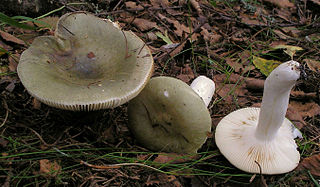
Russula aeruginea, also known as the grass-green russula, the tacky green russula, or the green russula, is an edible Russula mushroom. Widely distributed in northern temperate regions, it is usually found under birch, mostly in pine forests. The very poisonous death cap can have a similar appearance, especially from above.

Russula atropurpurea is an edible member of the genus Russula. It is dark vinaceous or purple, and grows with deciduous, or occasionally coniferous trees. It is commonly called the blackish purple Russula, or the purple brittlegill.

Russula delica is a mushroom that goes by the common name of milk-white brittlegill, and is a member of the genus Russula, all of which are collectively known as brittlegills. It is mostly white, with ochraceous or brownish cap markings, and a short robust stem. It is edible, but poor in taste, and grows in coniferous, broadleaved, or mixed woods. It can be confused with other white Russula species and certain white Lactarius species.

Russula fragilis, commonly known as the fragile russula, or fragile brittlegill, is a species of mushroom of the genus Russula, whose members are commonly known as brittlegills. It is a small, fragile, long stemmed, and variably coloured brittlegill, found in mixed forests, and woods in Europe, Asia, and North America.
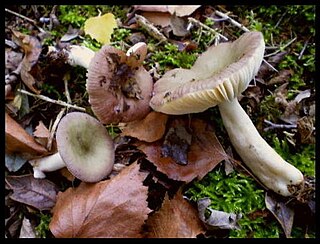
The mushroom Russula gracillima, commonly known as the slender brittlegill, is a member of the genus Russula, whose members are commonly known as brittlegills. It is a small, pale, long stemmed brittlegill associated mainly with birch and is occasional in Europe, Asia, and North America.
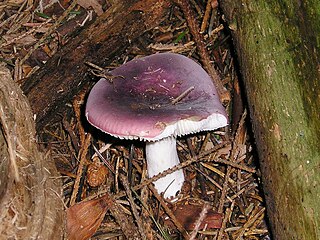
Russula turci is a common, edible, Russula mushroom, found under pines and spruces, on sandy soil and clay.
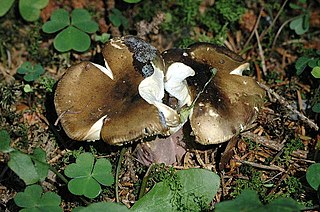
Russula olivacea is an edible and non-poisonous Russula mushroom found mostly in groups from June in deciduous and coniferous forests, mainly under spruce and beech; not rare.
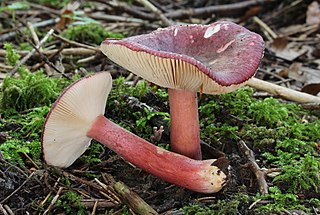
Russula queletii otherwise known as the gooseberry russula, is a common, inedible, Russula mushroom found growing in groups, predominantly in spruce forest. Eating this mushroom causes abdominal pains.

Russula densifolia, commonly known as the crowded russula or the reddening russula, is a species of agaric fungus in the family Russulaceae. It was first described in 1833 and given its current name in 1876. A widespread species, it is found in Asia, Europe, and North America, where it fruits on the ground in mixed and deciduous forests. Fruit bodies (mushrooms) are robust and squat, with caps up to 14.5 cm (5.7 in) in diameter, and stems that are 2–7.5 cm (0.8–3.0 in) long by 1.2–2.5 cm (0.5–1.0 in) thick. The mushrooms are characterized by the red and then black color changes that occur in the flesh when it is bruised, and a relatively thick cap cuticle. Although the mushroom is sold as an edible species in some areas of Asia, it is mild to moderately toxic, and may cause gastrointestinal upset if consumed. Several bioactive compounds have been isolated and identified from the mushroom.

Hygrophorus russula, commonly known as the pinkmottle woodwax, false russula, or russula-like waxy cap, is a fungus native to North America and Europe.




















